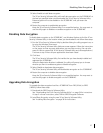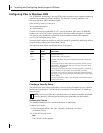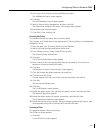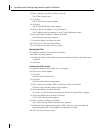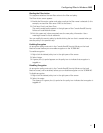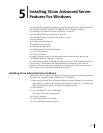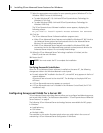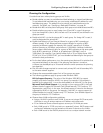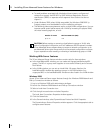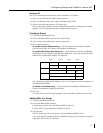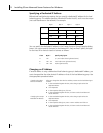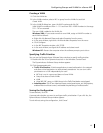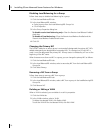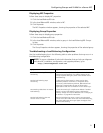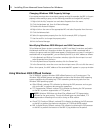
Configuring Groups and VLANs for a Server NIC
45
Planning the Configuration
Consider these items when planning groups and VLANs:
■ Decide whether you want to use bidirectional load balancing, or transmit load balancing.
To use bidirectional load balancing, you must assign a dedicated IP address for each
load balancing group. This address must be unique (not used elsewhere on the
network). For details, see “Specifying a Dedicated IP Address” on page 48.
■ Decide which NICs are to be part of each group. Each group must include at least two NICs.
■ Decide whether you want to use a foreign (non-3Com) NIC in one of the groups.
Up to two foreign NICs (that is, NICs that are not 3Com server NIC) are allowed in one
group per server.
■ Decide which NIC is to be the primary NIC in each group. If a foreign NIC is used, it
must be designated the primary NIC.
■ Disable load balancing if you have set failover for a group of NICs operating at
different speeds. 3Com Advanced Server supports failover for a group of NICs
operating at different speeds (for example, with one NIC operating at 10 Mbps,
another operating at 100 Mbps, and another at 1,000 Mbps). However, Advanced
Server supports load balancing only for a group of NICs operating at the same speed
(with all NICs operating at 10 Mbps, or all operating at 100 Mbps, or all at
1000 Mbps). For example, if you specify failover from a 3Com Gigabit Server 1000
PCI NIC to a 3Com 10/100 PCI NIC, you must disable load balancing for that group to
achieve the best performance.
■ For the best failover performance, turn the spanning tree feature off at switches that
are connected directly to the server. If the spanning tree feature is turned on,
a failover may be delayed up to 30 seconds while the switch processes the spanning
tree algorithm.
■ Plan the cable changes required to connect each primary NIC and all secondary NICs
to the same network segment.
■ Observe the recommended support limit of four groups per server.
■ The following guidelines apply to groups under Windows 2000:
802.1p Support Property—The value of the Windows 2000 802.1p support
property must be the same for all NICs in a group. For example, if this property is
enabled for the primary NIC, it must also be enabled for all other NICs in the group.
Microsoft Task Offload Support—It is possible to form a group of NICs that have
different levels of support for Microsoft Task Offload features (TCP Checksum, TCP
Segmentation, and IP Sec). In this case, the offload support is limited to the features
supported by all NICs in the group. For example, if two NICs in a group support all
offload features but one NIC supports only TCP Checksum, then offload support for
the group is limited to TCP Checksum.
■ Observe these VLAN configuration guidelines:
■ Assign a VLAN ID number to each VLAN. If you are not using a DHCP server, each
VLAN that is using IP services requires an IP address and subnet mask.
■ 3Com Advanced Server software supports as many as 16 VLANs per server.
■ Each VLAN bound to TCP/IP must exist on a separate IP subnet. DHCP servers used
to allocate IP addresses must be located on the same IP subnets as the VLANs.
■ Each VLAN bound to the IPX/SPX protocol must use a unique network number.



